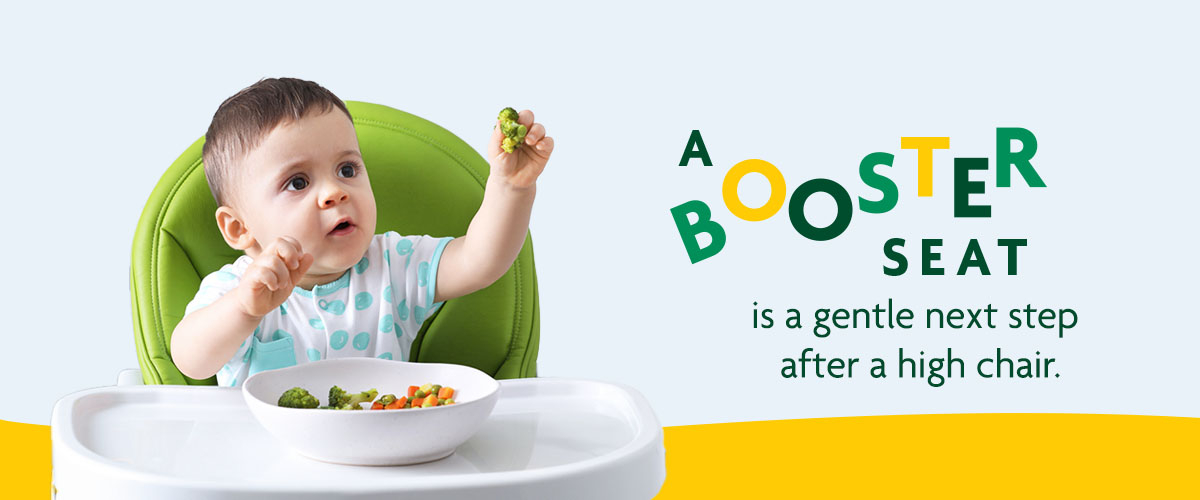A Parents Guide to Transitioning From High Chair to Table
Toddlerhood is an adventure filled with exciting milestones. One of these is moving from the high chair to join the family at the table. This transition is more than a seating change. It’s a step toward growing your toddler’s self-confidence. Every meal is a bonding and learning opportunity. Embrace this phase of exploration! All it takes is a little patience and creativity to create a joyful dining experience for your child.
Your toddler’s development and eating habits influence when to leave the high chair. This guide can help you identify the signs that your toddler is ready for the table. We also provide handy tips for a smooth transition.
At What Age Should a Child Stop Using a High Chair?
Transitioning to the table has no exact age. Infant feeding techniques can vary from child to child based on their development. When your toddler can sit upright in a seat and remain stable, they can move out of their high chair. It may be as early as between 15 and 18 months when your toddler can eat with a spoon or drink from a cup. However, remember that each child develops at their own pace. Your little one may take up to three years to be ready to say goodbye to the high chair.
Signs That Your Child Is Ready for the Table
The best way to tell if it’s time to transition from the high chair is by taking cues from your toddler. They will give you subtle (or not-so-subtle) hints, such as:
Sitting up Unassisted
Infants between 7 and 9 months old can start sitting up unassisted, but it takes longer for them to hold a steady position. Keep an eye on how long your child can remain upright. They may be ready to move to the table if they sit straight without support.
Reaching the Table
Your child may show interest in what’s happening at the table, indicating they want to join the family. They may be ready to move on from the high chair if they can reach the table and sit in a regular chair without help.
Climbing Out of Their Seat
Is your toddler channeling their inner Houdini and escaping from their high chair? It may be time to change seats! Undoing high chair straps suggests your child can handle sitting at the family table. You may also catch them trying out different seats around the house.
Outgrowing the High Chair
An uncomfortable child is less likely to enjoy mealtimes. If you find the high chair is a squeeze, your toddler may have outgrown it. Try switching to a bigger booster seat or regular chair to promote a more comfortable eating experience.
Understanding and Following Rules
As your toddler ages, they learn how to listen and understand instructions. See if your little one can follow simple rules at mealtimes, such as:
- Simon says to stay seated: You can expect some fidgeting, but it’s a good sign if your child sits through the meal.
- A chair is for sitting: Kids sometimes confuse chairs for jungle gyms. They should understand that rocking, standing, or lying on chairs is unsafe.
- Everything in its place: Bowls, cups, and utensils should stay on the table.
Your child should be ready to sit at the table if they can follow these instructions.
Displaying High Chair Hysterics
Your toddler may show signs of frustration or refuse to sit in the high chair. Kicking, screaming, and tantrums when approaching the chair says, “I’m not happy!” It may be time to transition if your toddler seems uncomfortable or restless in the high chair.
Wanting to Join In
Your child might start to notice that they do things differently from others. When they see older children sitting in “big kid” chairs, they may express interest in doing the same thing. They may mimic older siblings or adults by wanting to sit in regular chairs.
Becoming More Independent
Independence shows that your child is ready to leave the high chair. They may be more active, exploring their surroundings, walking or running without help. This independence can extend to eating skills. Your toddler might be better at self-feeding, handling utensils, or managing spills.
5 Tips for Smooth Transitioning From the High Chair
If all signs reveal your child’s readiness to move from the high chair to the table, follow these five tips for a smoother, more stress-free transition:
1. Switch to Booster Seats for Dining

A gradual change lets your child get used to new seating without a sudden routine disruption. A booster seat is a gentle next step after a high chair. This portable seat can lift to the perfect table height, offering a safe way for your little one to join the table. You can even let your child choose between the high chair and booster seat so they feel included. Adding an element of fun makes the transition easier.
Here are some of the benefits of booster seats:
- Self-sufficiency: Booster seats let your child sit at the table with the rest of the family. Immersing them in mealtimes gives them a sense of independence and belonging.
- Proper positioning: You can adjust the seat to the right height. This adaptability makes it easier for your little one to reach their food.
- Secured seating: Booster seats have features to keep your child safer. Straps attach the seat to a chair, while a safety belt prevents your toddler from climbing out.
- Enhanced comfort: Many seats have padding and back support for a more comfortable mealtime.
- Versatility: Portable booster seats are ideal for restaurant or home dining. They are also easy to store and clean. You can even take them along on vacation!
- Easier transition: A booster seat is a great middle step between high and regular chairs. Easing your child into a new routine can help them get used to the idea instead of a sudden change.
You could remove the tray and bring the high chair to the table as a booster seat alternative.
2. Start With a Child-Sized Chair
If your toddler refuses the booster and you feel uncomfortable with a regular chair, think smaller. Setting up a child-sized table with chairs can ease the transition. Kids’ chairs are much closer to the ground. Inviting your child’s friends to eat at their table can make them feel like “grown-ups.”
3. Create a Mealtime Routine
Routines are an essential part of childhood development — studies show that they can lead to positive cognitive and social-emotional behaviors in children. Creating a habit of mealtimes at the table instead of in front of the TV can reinforce a feeling of familiarity and establish a safe space for your toddler.
Even toddlers can benefit from the structure of a schedule. Consider putting together a daily schedule that includes family mealtimes and stickers to get them excited about joining family meals.
4. Find Ways to Make Meals Fun
Adding playfulness encourages your child to look forward to mealtimes at the table. A few ideas to liven up meals include:
- Theme nights: To excite and engage your child, you can add fun themes like “taco Tuesday” or “pizza party.”
- Role play: Turn your dining room into a pretend restaurant. You can take turns being the server or chef for a more interactive dining experience.
- Fun utensils: Toddlers love colors and textures. Use bright plates or rubber utensils to make mealtime feel like playtime. You could also use themed items with your child’s favorite character.
5. Use Positive Reinforcement
Showering your toddler with praise helps them feel proud of their transition. A little encouragement goes a long way.
Enhance Your Children’s Eating Experiences With Nurture Life
Transitioning from high chair to table is an exciting milestone in your child’s life. Serving them flavorful food that excites them can help make the transition easier. At Nurture Life, we understand you want to give your child healthy, nutritious meals. Our registered dieticians create delicious meals packed with the nutrients kids need. Fresh, ready-to-eat foods take the hassle out of mealtimes.
Take a look at our menus, which include Baby Finger Foods, Kids Meals, Superfood Smoothies, and Mighty Bites. Discover convenient, nutritious meals for healthy, happy kids!


